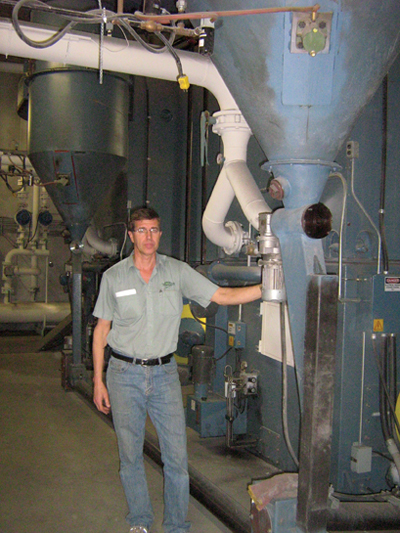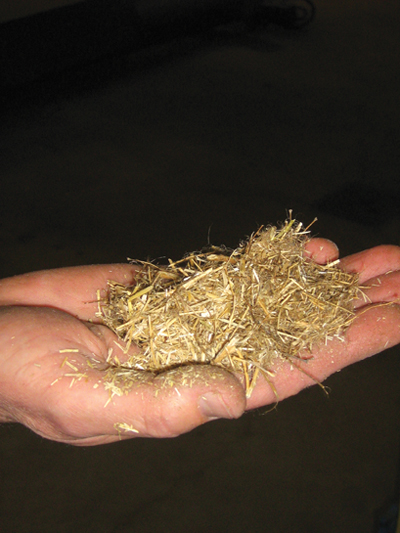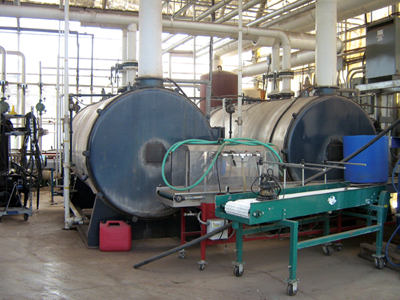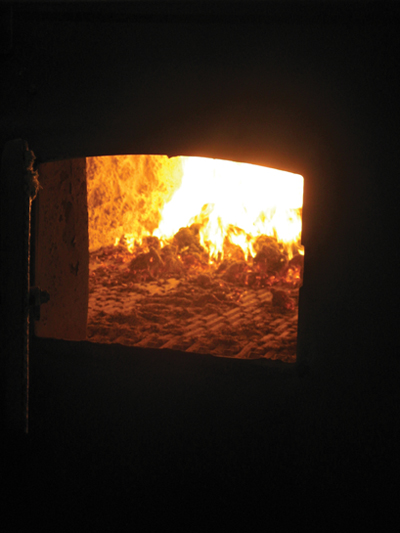
It’s a significant byproduct of a popular Canadian grain crop
Vanderveens’ Greenhouses, one of the largest greenhouse operations on the Prairies, was facing a dilemma shared by many other greenhouse growers.
 |
| Kelvin Vanderveen beside the hopper. |
“With gas prices for heating skyrocketing, we weren’t sure if we could economically stay open and keep growing throughout the winters anymore,” says Kelvin Vanderveen. “We needed to find an alternative source of heating.”
Their solution was to convert to biomass, and specifically flax shives. Vanderveen and his staff chose this fuel because flax is grown in quantity in the area and there is a plant nearby (Schweitzer-Mauduit Canada Inc.) that processes the flax.
“It works out well for everyone concerned,” says Vanderveen. “The manufacturer takes the fibre out of the flax and has the shives left over. We use the shives.”
The non-fibre parts of the flax stem, not including the seed, are usually referred to as shives. In oilseed flax, shives make up from 70 to 85 per cent of the total straw weight and in fibre flax varieties they make up from 50 to 75 per cent of the total straw weight. Shives are a significant byproduct of flax straw processing plants.
Western Canada grew some 633,500 tons of flax in 2007-08. In addition to great flavour, flax has numerous nutritional benefits, especially its omega-3 fatty acid, lignan and dietary fibre content.
Vanderveens’ Greenhouses is a second-generation, family-operated business based in Carman, Manitoba, about 60 kilometres southwest of Winnipeg. Three years ago, the company invested in new boiler equipment, much of it custom-made (by Blue Flame Stokers out of Headingly, Manitoba, just outside of Winnipeg) to burn shives.
 |
| A handful of shives |
 |
| Gas boilers supplement heating on extremely cold days. |
 |
| The company expects to recoup its investment in the new biomass heating system in about five years through energy savings. |
MUCH OF THE SYSTEM WAS CUSTOM-MADE
“We adapted coal-burning boilers,” Vanderveen explains. “Blue Flame helped us change the hoppers and the transportation system. We also needed new cyclones for the ash because shives produce ash that is much lighter than coal ash.
“No one else in the world, to our knowledge, is burning flax shives to generate heat.”
Vanderveen notes that it took about six months to work the kinks out. The system is computer-controlled, he notes, but the settings have to be changed frequently for maximum efficiency because each load of shives has a different moisture level that changes the feed/air ratio.
The system also needs quite a bit of maintenance. Vanderveen has one employee looking after the system on a full-time basis.
Vanderveens’ Greenhouses burns 50 tons of shives – the equivalent of three trailer loads – a day to heat its 900,000 square feet of greenhouse space.
ANTICIPATING A PAYBACK IN FOUR TO FIVE YEARS
“Based on the price of gas about a year ago, we were expecting to recoup our investment in four to five years from what we save on heating with our new equipment.”
They still have their natural gas-powered boilers. These are used to supplement the heating in the coldest part of the winter. “We heat the greenhouses year-round, except for July.”
Such a system isn’t for everyone. Vanderveen doesn’t recommend switching to biomass for heating for smaller greenhouses. “The cost of the investment doesn’t pay for smaller operations,” he suggests.
He recommends that larger greenhouse operators considering replacing their current heating systems should talk to other greenhouse operators who have already had experience with biomass heating.
“It’s best to learn from others’ mistakes and how to fix problems that may occur.”
Myron Love is a freelance writer and photographer in Winnipeg.
Print this page